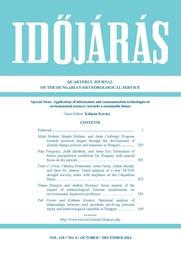IDŐJÁRÁS - angol nyelvű folyóirat
Vol. 118, No. 4 * Pages 293–378 * October - December 2014
Progress towards emission targets through the development of climate change policies and measures in Hungary
Márk Molnár, Sándor Molnár, and Anita Csábrági
idojaras.2014.4.1 (p. 293–)
Márk Molnár, Sándor Molnár, and Anita Csábrági
idojaras.2014.4.1 (p. 293–)
Estimation of future precipitation conditions for Hungary with special focus on dry periods
Rita Pongrácz, Judit Bartholy, and Anna Kis
idojaras.2014.4.2 (p. 305–)
Rita Pongrácz, Judit Bartholy, and Anna Kis
idojaras.2014.4.2 (p. 305–)
Trend analysis of a new MODIS drought severity index with emphasis on the Carpathian Basin
Péter I. Orvos, Viktória Homonnai, Anita Várai, Zoltán Bozóki, and Imre M. Jánosi
idojaras.2014.4.3 (p. 323–)
Péter I. Orvos, Viktória Homonnai, Anita Várai, Zoltán Bozóki, and Imre M. Jánosi
idojaras.2014.4.3 (p. 323–)
Some aspects of the impact of meteorological forecast uncertainties on environmental dispersion prediction
Tímea Haszpra and András Horányi
idojaras.2014.4.4 (p. 335–)
Tímea Haszpra and András Horányi
idojaras.2014.4.4 (p. 335–)
Statistical analysis of relationships between road accidents involving personal injury and meteorological variables in Hungary
Pál Vécsei and Kálmán Kovács
idojaras.2014.4.5 (p. 349–)
Pál Vécsei and Kálmán Kovács
idojaras.2014.4.5 (p. 349–)
IDŐJÁRÁS folyóirat

Az IDŐJÁRÁS a HungaroMet Nonprofit Zrt. negyedévenként megjelenő angol nyelvű folyóirata
Megrendelhető a journal.idojaras@met.hu címen.
A szerzőknek szánt útmutató itt olvasható.
Megrendelhető a journal.idojaras@met.hu címen.
A szerzőknek szánt útmutató itt olvasható.










